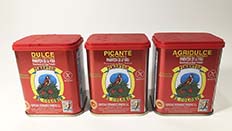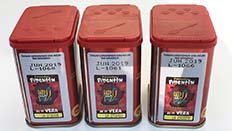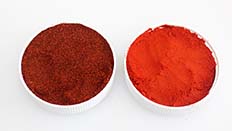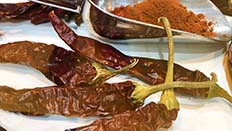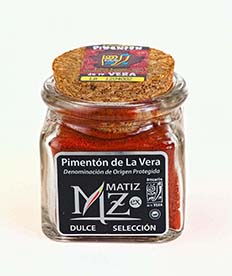Meats and Sausages
Pimentόn and Pimentón de La Vera
After discovering America in 1492, Christopher Columbus made his first pilgrimage to Santa María Monastery of Guadalupe in Extremadura where he thanked heaven for his discovery. In 1493, on his third trip, Christopher Columbus brought the first peppers to Spain which were offered to the monks of Guadalupe monastery. From there, production expanded to the Monastery of Yuste in Cáceres, Extremadura, and then to Murcia, La Rioja, and Andalusía. The process was held in secrecy but with time the product became known as Pimentón de La Vera.
Extremadura of Spain produces most and all varieties of pimentón (sweet, bitter-sweet and hot), but some sweet pimentón is also made in Murcia. There are 4 varieties of peppers (Bola, Jaranda, Jariza, Jeromín); by selecting and processing them in certain ways three types of pimentón are produced:
- Sweet (dulce)
- Semi-sweet (agridulce)
- Hot (picante)
The peppers are harvested and dried over burning oak wood in tall chambers that do not differ much from old smokehouses. The drying continues for 10-15 days. Then, the seeds and stems are removed and peppers are milled into a powder.
In Extremadura, there are 17 licensed companies that produce Pimentón de La Vera under own label. Each container displays a Protected Designation of Origin (PDO) logo and an individual serial number. When a recipe does not specify which pimentón is needed the sweet (dulce) pimentón is usually added. By mixing sweet (dulce) and hot (picante) pimentón together a customized solution can be produced. The Regulatory Council (Consejo Regulador www.pimentonvera-origen.com) is in charge of all matters related to the production of Pimentón de La Vera.
Note: It is quite common to come across the definition of pimentón as smoked paprika, which is not correct. Pimentón is Spanish paprika which is usually not smoked unless the label states otherwise. Only Pimentón de La Vera is always smoked. Spanish sausages such as chorizo, sobrasada and others display a unique, vivid red color, which is due to pimentόn. Sweet paprika used for general cooking may be Hungarian, Californian, or South American but Spanish pimentόn is darker and has a more intense flavor.
In order to be labeled chorizo the sausage must include pimentón; if made without it, the sausage becomes white chorizo (chorizo blanco). Many Spanish sausages, for example, Chorizo Cantipalos, must include the highest quality pimentόn called Pimentón de La Vera. This smoked pimentόn is produced in La Vera municipality, Cáceres province in Extremadura region, where farmers harvest and dry the chiles over wood fires, creating smoked paprika or pimentón de La Vera. It has received European Protected Designation of Origin (PDO) in 2007. Pimentón is also produced in Murcia region of Spain and on the island of Majorca.
Unlike black pepper or other spices, which are added to sausages at 0.1-0.3% per 1 kg of meat, pimentón is added to chorizos at 1-3% which is ten times more. At first, it seems to be an error, as any spice such as pepper, nutmeg, or cinnamon added to meat above 3% can make the product non-edible, however, pimentón fits just fine. Another benefit of pimentόn is that it contains a large percentage of sugar (10%) that positively contributes to lactic acid production during fermentation, and is an anti-oxidant delaying fat rancidity.

